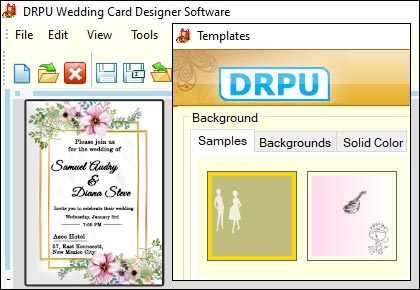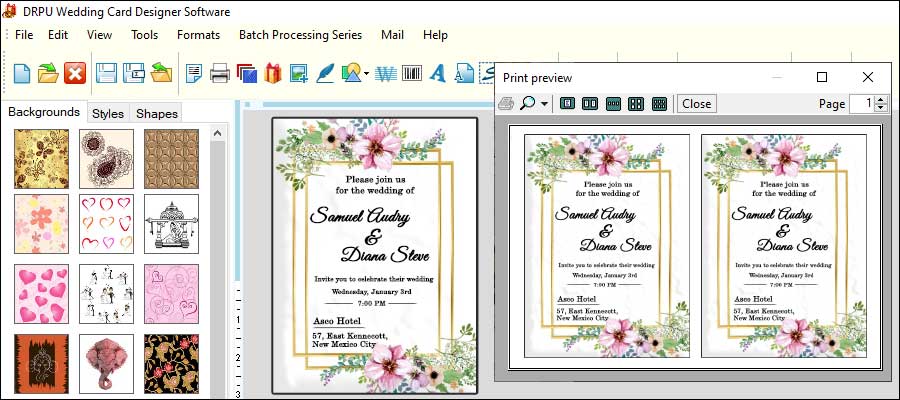Using Templates, Graphics and Tools for Designing Wedding Card
Designing a wedding card is a creative and exciting task that requires careful planning, attention to detail, and the use of the right tools. here are some tips on how to use design templates, graphics, and text editing tools to create a wedding card design from scratch or modify an existing one:-
-
Choosing the Right Design Software:
Before we start designing a wedding card, we need to choose the right design software that will enable us to create professional-quality designs. Some of the most popular design software programs for creating wedding cards include Adobe Photoshop, Adobe Illustrator, and CorelDRAW. These software programs offer a wide range of tools and features that are specifically designed for creating graphics, images, and text for print.
-

-
Setting Up the Document:
Once you have chosen your design software, the next step is to set up the document. To create a wedding card, you will need to create a new document with the appropriate dimensions, resolution, and color mode. For example, a standard wedding card size is 5 x 7 inches, and the resolution should be set to 300 dpi. The color mode should be set to CMYK if you are designing for print.
-
Choosing a Design Template:
Design templates are pre-designed layouts that can be customized to create a unique wedding card design. Many design software programs offer a wide range of design templates that you can choose from. You can select a design template that matches the theme or style of the wedding, or you can choose a template that you like and modify it to suit your needs.
-
Adding Graphics:
Graphics are an essential part of any wedding card design. You can use graphics to create a unique design that reflects the personality and style of the couple. There are many different types of graphics that you can use, including clipart, illustrations, photographs, and patterns.
When choosing graphics, it is important to consider the theme of the wedding and the overall design of the card. For example, if the wedding has a rustic theme, you might want to use images of flowers, trees, and other natural elements. If the wedding has a modern theme, you might want to use geometric shapes, patterns, and clean lines.
-
Adding Text
Text is another essential element of any wedding card design. You can use text to convey important information about the wedding, such as the date, time, and location. You can also use text to include a personal message to the couple.
When adding text to your design, it is important to choose the right font and size. You should also consider the color of the text and how it will stand out against the background of the design. Be sure to use a font that is easy to read and appropriate for the style of the card.
-
Editing and Refining the Design
Once you have added your graphics and text to the design, it is time to refine and edit the design. You can use various editing tools and features to adjust the layout, color, and overall appearance of the card. You can also experiment with different design elements to see what works best.
When editing the design, it is important to pay attention to the details. Make sure that the text is aligned correctly and that the graphics are placed in the right position. You should also check the spelling and grammar of the text to ensure that there are no errors.
-
Printing and Finalizing the Design
When you are satisfied with your wedding card design, it is time to print and finalize the design. You can print the design yourself if you have the necessary equipment and materials, or you can send the design to a professional printing service.
Before finalizing the design, it is important to check the dimensions, resolution, and color mode to ensure that the design will print correctly.
Customization The Wedding Card Design to Reflect The Couple's Personal Style
Customizing a wedding card design to reflect a couple's personal style, preferences, and cultural or religious background can be done in several ways. Here are some tips on how to achieve a personalized design:
-
Research:
Start by researching the couple's cultural or religious background. This can give you an idea of the colors, symbols, and imagery that would be appropriate for their wedding card. You can also look for inspiration online, in magazines, or in design books.
-
Consult with the Couple:
Meet with the couple to understand their personal style and preferences. Ask them about their favorite colors, fonts, and design elements. This will help you create a design that truly reflects their tastes.
-
Choose the Right Colors:
Colors play a significant role in the design of a wedding card. Different cultures and religions have their own traditional colors that are considered auspicious or meaningful. For example, in Hindu weddings, red is a popular color because it symbolizes love and passion. Similarly, in Chinese weddings, red and gold are commonly used because they represent good luck and prosperity.
-
Select the Right Fonts:
Fonts can convey a lot about the style and tone of a wedding card. Choose a font that complements the design and reflects the couple's personality. For example, a cursive font can convey elegance and sophistication, while a bold font can be more playful and modern.
-
Use Appropriate Imagery:
Imagery can also play a significant role in customizing a wedding card design. Depending on the couple's cultural or religious background, you may want to incorporate traditional symbols or motifs. For example, a Jewish wedding card may feature a Star of David, while an Indian wedding card may have a peacock or lotus flower.
Overall, creating a personalized wedding card design requires a thoughtful approach that takes into account the couple's unique style, preferences, and cultural or religious background. By following these tips, you can create a design that truly reflects the couple and makes their special day even more memorable.
Preview and Test The Wedding Card Design for Accuracy
Previewing and testing a wedding card design is an important step to ensure its accuracy, clarity, and accessibility. In this process, you need to simulate different screen sizes, printing options, and color modes to ensure that the design looks good and readable across all platforms.
Here are some ways to preview and test the wedding card design:
-
Simulate Different Screen Sizes:
When designing a wedding card, it is important to consider how it will appear on different devices and screen sizes. To simulate different screen sizes, you can use various online tools that allow you to view the design on different devices such as smartphones, tablets, laptops, and desktops. You can also use the responsive design mode in web browsers like Google Chrome, which allows you to view the design in various screen sizes.
-
Check for Clarity:
It is important to ensure that the design is clear and readable across all platforms. To test the clarity of the design, you can zoom in and out on the design to ensure that the text and images are legible. You can also test the design with different font sizes to ensure that the text is readable for all users.
-
Check for Accessibility:
Accessibility is important to ensure that the design is accessible to all users, including those with disabilities. To test the accessibility of the design, you can use online accessibility tools that test the design for color contrast, text size, and font type. These tools can help you identify any accessibility issues and make necessary adjustments to the design.
-
Simulate Different Printing Options:
To ensure that the design looks good when printed, you need to simulate different printing options. You can do this by printing the design on different printers and paper types to see how the design looks. You can also use online printing services that allow you to preview the design before printing.
-
Simulate Different Color Modes:
Different color modes can affect how the design appears on different devices and printing options. To simulate different color modes, you can use online tools that allow you to view the design in different color modes such as RGB, CMYK, and Pantone. This will help you ensure that the colors in the design are consistent across all platforms.